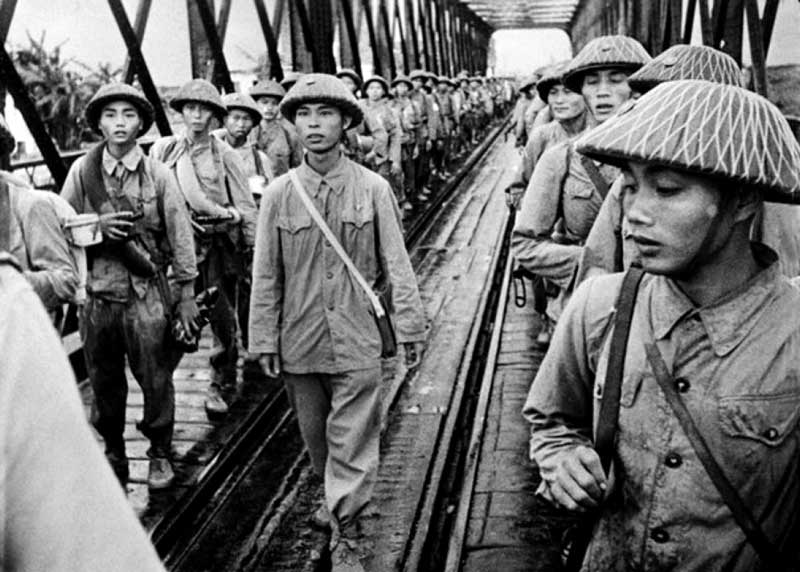Total War | History Today - 4 minutes read

Christopher Goscha’s The Road to Dien Bien Phu is a brilliantly revised and expanded version of his 2011 French-language work Vietnam: Un État né de la guerre, 1945-1954. It explores the means, tactics and strategies employed by Vietnamese communist authorities under Ho Chi Minh during the First Indochina War, fought – and won – against the occupying French forces for more than seven years.
The book shows how the communist-led Democratic Republic of Vietnam (DRVN), proclaimed by Ho on 2 September 1945, prevailed in its war against the French and their indigenous allies, despite its fragmented, decentralised and contingent nature. While scholars have traditionally considered Vietnamese nationalism and the way it was harnessed by Ho and his comrades as central to determining the war’s outcome, Goscha contends that the ‘nervous system’ created by Vietnamese communist leaders to achieve operational coherence within their ‘archipelago state’ – and support from their Chinese counterparts – proved equally if not more important in shaping the war’s outcome. Laudatory notions of a ‘nation-in-arms’ and a ‘people’s war’ were myths, propagated by the leaders themselves to legitimise coercive war-waging and nation-building projects. What makes the First Indochina War so complicated and yet so fascinating, Goscha argues, ‘is how the communists lined up behind Ho Chi Minh rolled nationalism, communism and war into one vital force’.
From the communist perspective, the First Indochina War was a tale of two successive conflicts. In the first, from 1945 until 1949, the strategic goal was to create a broad national resistance front and volunteer army ‘capable of bogging the enemy down in small-scale operations’. That army consisted of poorly trained soldiers and battalion-size units conducting guerrilla operations in their home regions. Weapons and vital hardware were purchased from abroad, homemade or stolen. Pragmatism and survival were the order of the day.
Everything changed following the communist victory in China in October 1949. Emboldened and aided by their northern comrades, Vietnamese communist leaders undertook ‘a military revolution unknown in any other war of decolonization in the twentieth century’. Thus began the conflict’s second act, in which ideology was everything. Just as Lenin had done in Russia in the immediate aftermath of the October Revolution in 1917, Ho applied a so-called policy of ‘war communism’ in areas under DRVN control with the intention of mobilising maximal human and material resources. Mandatory military service for men aged between 18 and 45 started in November 1949, followed in February 1950 by a general mobilisation law for legally conscripting and organising civilians into ‘work teams’ to build and protect the party state. The masses had been co-opted. Meanwhile, patriotic land reform campaigns, based on Chinese models, politicised and incentivised peasants, the backbone of the revolution, even as authorities ‘squeezed the agricultural sector and its farmers for everything they had’.
The DRVN strengthened and consolidated itself to the point that its armed forces became a redoubtable standing divisional army, versed in modern military science and equipped with sophisticated weaponry, courtesy of the Chinese. Mobile and capable of fighting pitched battles, the People’s Army of Vietnam comprised no less than seven divisions averaging 20,000 men each by the time of the climactic Battle of Dien Bien Phu in March 1954. Because of this, argues Goscha, the level of violence witnessed in Vietnam has no equivalent in the history of 20th-century wars of decolonisation.
Reading Goscha’s book, I was struck by how his account of communist travails during the First Indochina War offers answers to lingering questions about the outcome of the second. The subsequent conflict, involving the United States, effectively afforded DRVN leaders an opportunity to do it all over again with the benefit of invaluable lessons just learned. No wonder, then, that they triumphed even more completely in that war than they did in the first. The Americans and their allies were no match for enemies far more seasoned in the arts of war and nation building – and accustomed to self-sacrifice. The Road to Dien Bien Phu showcases the ingenuity and resourcefulness of ideologically driven authorities obstinately struggling to overcome technological, economic and other deficits with a view to satisfying aspirations that were, in the final analysis, as narrow as they were unshakable.
The Road to Dien Bien Phu: A History of the First War for Vietnam
Christopher Goscha
Princeton University Press 568pp £28
Buy from bookshop.org (affiliate link)
Pierre Asselin is the Dwight E. Stanford Chair in American Foreign Relations in the Department of History at San Diego State University and author of Vietnam’s American War: A History (Cambridge University Press, 2018).
Source: History Today Feed